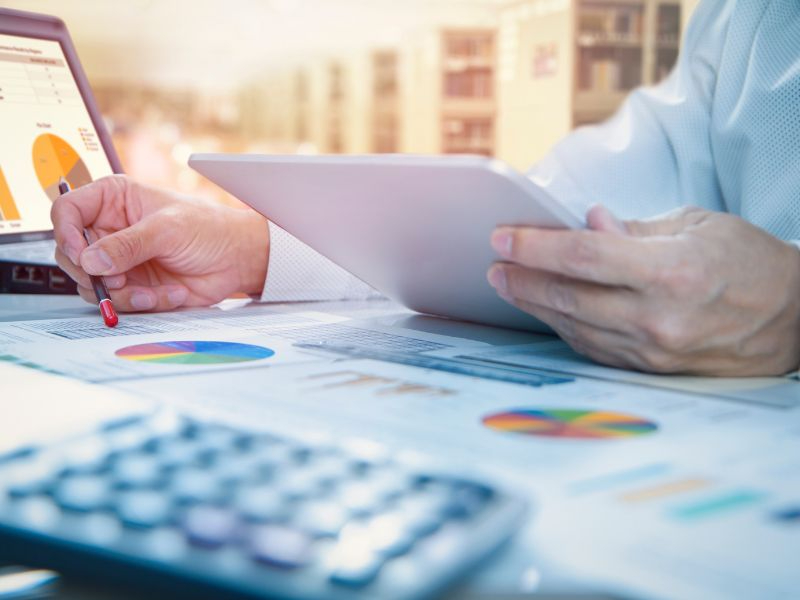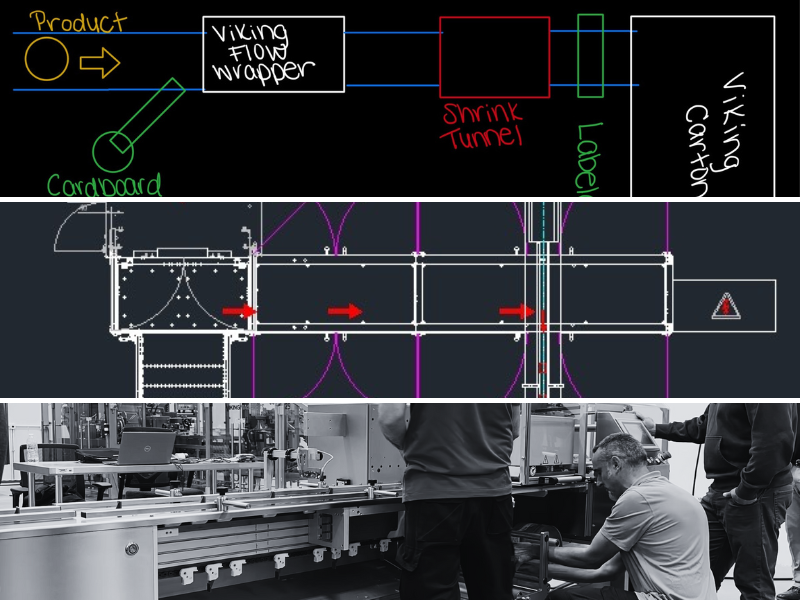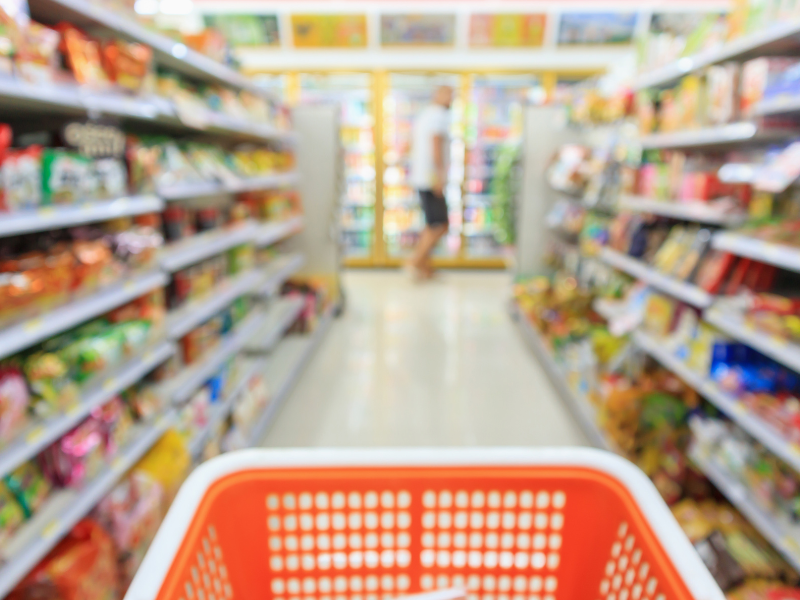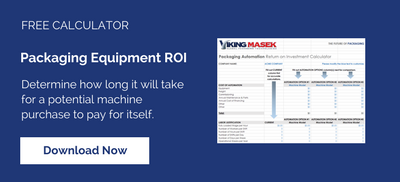How to calculate the ROI on a potential packaging machine purchase
By Danielle Ohl on June 1, 2023

Whether you're new to packaging automation or an old hand at capital equipment procurement, return on investment calculations are a key part of the vetting process.
You will want to know how long it will take to recoup your initial investment, and what the ROI of one piece of packaging equipment is in comparison to another. So how do you go about making these important calculations? Our experts break it down below:
Short on time? We took care of all the math for you.
Download our free capital equipment ROI calculator >>
Why machine ROI is important
First, we need to explain why calculating return on investment for a potential packaging machine purchase is so important. It really comes down to one thing: You need to be sure that any investment in capital equipment will be profitable for your company. You've got a lot riding on this decision, after all.
Sounds like common sense, right? But you'd be surprised at how few companies actually run the numbers before purchasing a packing machine. It takes some time and effort, but the results can be invaluable to your decision-making.
And if you think ROI considerations are one and done, think again! Over the entire lifespan of the packing machine, you need to consistently be aware of (very avoidable) mistakes that will erode or even kill profit and efficiency gains.
So without further delay, let's jump right into a step-by-step explanation of how to calculate the return on investment for your next equipment purchase:
How to calculate return on investment for equipment purchases
To calculate the ROI of that new packaging equipment you've been eyeing, you first need two important numbers:
- Annual cost of your current packaging process
- Estimated annual net benefit/loss of the new packaging equipment
ROI formulas help you compare these two numbers in a meaningful way that reveals whether it makes sense financially to invest in that new automated packaging system.
Let’s start with number 1…
1. Calculate the total cost of new packaging equipment
When purchasing automated packaging equipment, you must take into consideration more than just the price tag on the machine. Your ROI calculations will be most accurate if your equipment cost represents the total cost of ownership including factors like:
- Equipment purchase price
- Freight costs
- Commissioning and installation costs
- Training costs
- Annual maintenance and parts expenses
These costs will vary widely and are hard to estimate, so we recommend contacting a packaging equipment manufacturer to request more information about machine costs specific to your application and business needs.
Now that you know the total cost of ownership of the new equipment you are considering, it’s time to…
2. Calculate the net benefit/loss of investing in new equipment
A major piece of ROI calculations is the total dollar amount you expect to gain or lose if you purchase the new equipment. There are 3 main categories to consider when making these comparisons:
Annual labor costs
A. First, determine the current fully loaded wage per hour for your packaging staff. This includes not only the rate of pay, but the cost of benefits like insurance, paid time off, and other employee perks. Then do the math to figure out your total labor cost per year, inclusive of all employees that work on your packaging line.
B. Next, calculate the same thing but this time consider how your labor costs would change with a new automated packaging system. Your fully loaded wages per hour may not differ, but the number of employees required after implementing automation will probably change. Often this means the number of employees required to run a packaging line will decrease, sometimes by half or more.
Once you’ve calculated both numbers, subtract B from A to arrive at your estimated labor gain/loss. Jot this number down for later.
Annual gross profit
A. First, begin with calculating how many packages are currently produced annually and what your profit per package is in dollars (or your local currency). Multiply those together to get your annual gross profit from packaging activities.
B. Next, calculate the same thing but this time consider how your gross profit will change with packaging automation. Using the specifications provided by packaging equipment manufacturers (check out their website or give them a call), you can learn how many packages you could expect to produce after implementing automation. Throughput specifications are often represented as bpm (bags per minute) or cpm (cycles per minute). Multiplying this number by the hours spent packaging per day, the number of days per week, and operational weeks per year will give you an annual estimation. Then multiply your estimated packages produced per year with the new equipment by your profit per package.
Now subtract the number in A from B to arrive at your estimated gross profit gain/loss. Jot this number down for later.
Annual expenses unique to your business
A. Current packaging-related expenses could include things like scrap and rework and the value of the plant space currently occupied by your packaging line.
B. Potential costs with a new packaging system could include things like engineering or R&D of a custom packaging system or commissions you may pay third-party integrators. This could also include the value of plant square footage gained when consolidating multiple manual packaging areas into the smaller footprint of a machine.
Now subtract B from A to arrive at your net gain/loss, and jot this number down for later.
3. Perform return on investment calculations
Still with us? We’re almost done.
Now add up the net gain/loss from all 3 categories in step 2 above to arrive at your total net gain/loss generated by the new equipment. You will plug this number, along with the total cost of ownership for the new equipment, into the ROI formulas below.
Simple Return on Investment (ROI) formula
A standard definition of ROI is the ratio of a benefit or loss made in a fiscal year expressed in terms of an investment and shown as a percentage. The ROI formula for equipment purchases is as follows:
(Net benefit or loss generated by new equipment / Total new equipment cost) x 100
As an example, if you are considering purchasing a packaging system for $200,000 and predict a net annual benefit of $150,000 (via labor savings and profit from increased throughput), your return on investment will be:
($150,000 / $200,000) x 100 = 75%
Payback period (PBP) formula
The payback period calculates how much time it will take to recoup the initial investment. In packaging equipment terms, the payback period formula is as follows:
Total new equipment cost / Total periodic benefit realized from new equipment
Using the same example above of $200,000 equipment cost and $150,000 net annual benefit, the payback period will be:
$200,000 / $150,000 = 1.3 years
The cost of waiting to automate your packaging
While not a typical part of ROI calculations, the cost of waiting to automate your packaging should be considered. Each day you package your product manually, you are expending valuable resources that could be used more efficiently.
The savings that could be realized in labor reduction and increasing throughput with automated packaging equipment can be substantial, adding up to hundreds of thousands or even millions of dollars per year. That's no small change.
How to interpret your ROI results
Return on investment is a useful data point when making the case for a new packaging system investment. It can help answer the following questions:
- Will the new equipment bring a net gain or loss?
- Should we buy this equipment right now?
- How profitable will this investment be?
- Which equipment should we choose to maximize profits?
In general, a positive ROI result indicates a favorable outcome. When comparing multiple packaging equipment solutions, a higher ROI on one can highlight the better choice.
So what if your ROI result is a negative number? Generally, this indicates a net loss within that time period and to move forward with caution or not at all. One thing to consider about negative ROI - many investments result in a net loss in year 1 only to improve over time.
Keep in mind that return on investment calculations are only a piece of the puzzle. These numbers are a good starting point. If your calculations indicate a positive ROI, then you can dive into a more comprehensive vetting process to determine if an automated packaging system is the right decision for your company right now.
And remember that return on investment calculations are only as accurate as your data. If your numbers are fuzzy, your ROI will be too. You don't want to make big decisions based on faulty or incomplete numbers. Additionally, ROI does not take into consideration the inherent risk or uncertainty of a potential capital equipment investment.
Your machine ROI numbers will tell a story, but remember it's not the whole story. We are packaging equipment manufacturers and not financial advisors, so run your ROI calculations past an expert before making a final decision.
Download our free capital equipment ROI calculator to do the work for you
Put your calculator away. Don't worry about creating complex formulas on a spreadsheet. We took care of all the work for you!
Check out our free Excel spreadsheet for calculating return on investment for equipment purchases:
Related Posts

Optimizing packaging efficiency: The role of Flow Wrapping Machines in integrated systems

Unwrapping Tomorrow: Exploring the Latest Food Packaging Trends

